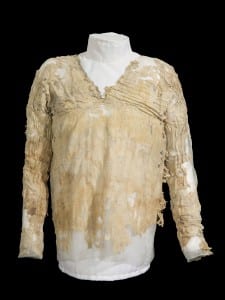Fashions that are dated but timeless: the Petrie Museum wardrobe
By Alice Stevenson, on 7 March 2016
Fashion month has recently passed, with all eyes on the latest trends, cuts, and colours. Vintage styles are frequently reimagined on the catwalk, but designers could find inspiration elsewhere in London from the most vintage garment of them all: the Tarkhan dress. It has just been confirmed as not only the oldest known from Egypt, but the most ancient complex woven garment in the world. It is more than 5000 years old.
The Tarkhan dress has received a lot of media attention since the announcement. Despite its Kanye West look, its preservation is still extraordinary; the fineness of the linen, the quality of the stitching, and the pleated detailing of the sleeves and bodice. It is, however, only one of many highlights from the Petrie Museum’s wardrobe.
Almost as impressive in age as the Tarkhan dress are two floor-length, figure hugging linen tunics found during excavations led by Petrie at Deshasheh that date to roughly 2500 BC. They give an insight into how the Tarkhan dress may have once looked. At about 55 inches in length, these dresses were much longer than any maxi-dress of today and were probably never worn. Instead, they were most likely intended to be used as funerary goods.
Of around the same date as the Deshasheh numbers is another star item in the collection – a bead net dress. It is one of only two known, the other being in the Boston Museum of Fine Arts. The dress was not found as a complete item at the time of excavation in 1923, rather it was simply a pile of hundreds of faience beads in a box at the end of a burial. Egyptologist Guy Brunton was nevertheless quick to identify it as the attire of a dancer whose erotic movements would have been accompanied by the rattling of the dress’ shell beads. Yet his interpretation, and the dress’ recent reconstruction, may owe more to familiarity with the flapper dresses that were all the rage in the 1920s, than ancient reality. It is possible that the ‘dress’ was actually a sort of net overlay for a mummy, rather than garb worn in life.

The ‘Bead net dress’ when it was first displayed in the Petrie Museum. More of a net than a dress (UC17743)
Elsewhere in the Petrie are other items of clothing, albeit not as complete. For fashionistas that have clocked that sleeves are a key feature of 2016’s catwalks, there is a pair in the Petrie Museum that might be of interest. Dating to Egypt’s New Kingdom (1550 BC – 1185 BC) these sleeves from a child’s costume were made separately. They would have been attached to garments only when required – quite a useful feature that could be adopted today to cope with the transition between the British summer and autumn seasons!
Designers and historians of costume need not only look to our object collections for inspiration. They could also explore our photographic archives which includes several insights into western fashions of the late 19th and early 20th century. Amara Thornton, for instance, has drawn attention to an image of Beatrice Orme who joined Hilda and Flinders Petrie on excavation between 1898 and 1902. On the back of the photo are the words “The best length for a skirt in Egypt!!” Thornton has noted that it is possible that the skirt she sports here would have been worn for cycling. Her more masculine shirt and tie were a look adopted by many “New Women” of the period who were entering the world of work and higher education.

“The best length for a skirt in Egypt!!” Beatrice Orme in Egypt in the early years of the 20th century. Petrie Museum archives.
More information about the Petrie’s textile collection can be found in our recently published ‘Characters and Collections’, which is free to download from UCL Press. For the Tarkhan dress specifically there are now several news stories in many different languages. Here’s just a selection of some seventy odd news outlets that picked up the story:
- http://news.nationalgeographic.com/2016/02/160218-oldest-dress-egypt-tarkhan-archaeology/
- http://news.discovery.com/history/ancient-egypt/oldest-known-dress-made-more-than-5000-years-ago-160218.htm
- http://www.dailymail.co.uk/sciencetech/article-3453364/Now-S-vintage-5-000-year-old-Egyptian-garment-confirmed-world-s-oldest-dress.html
- http://www.independent.co.uk/news/uk/worlds-oldest-dress-found-to-date-back-5500-years-a6883791.html
- http://www.culture24.org.uk/history-and-heritage/archaeology/art547149-petrie-museum-archaeology-oldest-woven-garment
- http://nytlive.nytimes.com/womenintheworld/2016/03/02/egyptian-dress-confirmed-as-worlds-oldest-woven-garment/
- http://www.ibtimes.co.uk/5000-year-old-egyptian-tarkhan-dress-declared-worlds-oldest-woven-garment-1544803
- http://www.gizmodo.com.au/2016/02/this-threadbare-garment-is-officially-the-worlds-oldest-dress/
- http://www.ancient-origins.net/news-history-archaeology/dated-fashion-tarkhan-dress-oldest-woven-garment-world-005400
- http://www.pasthorizonspr.com/index.php/archives/02/2016/tarkhan-dress-is-worlds-oldest-known-woven-garment
- http://www.thehistoryblog.com/archives/40770
- http://www.visiontimes.com/2016/02/24/the-tarkhan-dress-confirmed-to-be-the-worlds-oldest-dress.html
- http://www.newhistorian.com/the-tarkhan-dress-brings-new-meaning-to-vintage/6002/
- http://www.techtimes.com/articles/134811/20160219/you-cant-go-more-vintage-than-worlds-oldest-known-dress-from-more-than-5-000-years-ago.htm
- http://mentalfloss.com/article/75896/dress-least-5100-years-old
- http://www.archaeology.org/news/4197-160219-egypt-tarkhan-dress-worlds-oldest
- http://hyperallergic.com/279242/a-5000-year-old-linen-dress-is-the-worlds-oldest-woven-garment/?utm_medium=email&utm_campaign=A 5000-Year-Old Linen Dress Is the Worlds Oldest Woven Garment&utm_content=A 5000-Year-Old Linen Dress Is the Worlds Oldest Woven Garment+CID_b032ea42250e4c5b0834f0264e194a19&utm_source=HyperallergicNewsletter&utm_term=A 5000-Year-Old Linen Dress Is the Worlds Oldest Woven Garment
- https://nplus1.ru/news/2016/02/20/oldest-dress-known
- http://www.scientias.nl/dit-is-de-oudste-jurk-ter-wereld/
- http://www.nationalgeographic.com.es/historia/actualidad/este-es-el-vestido-mas-antiguo-del-mundo_10154
- http://news.discovery.com/history/ancient-egypt/oldest-known-dress-made-more-than-5000-years-ago-160218.htm
3 Responses to “Fashions that are dated but timeless: the Petrie Museum wardrobe”
- 1
-
2
Millie cox wrote on 11 January 2019:
This article is interesting. I always think deep into fashion and beauty, especially after a movie on the matter. The human body hasn’t changed much over time. We have two arms and two legs and we need to cover our skin for warmth and protection. It would be very cool to travel through the ages and see the clothes people wore!
-
3
Lilly Herman wrote on 25 October 2020:
Astonishing and beautiful! to see some amazing designs from 1000s years back. The maxi dress is more elegant than what we see today.
 Close
Close





[…] Egyptian linen dress, Petrie Museum University College London, museum number […]